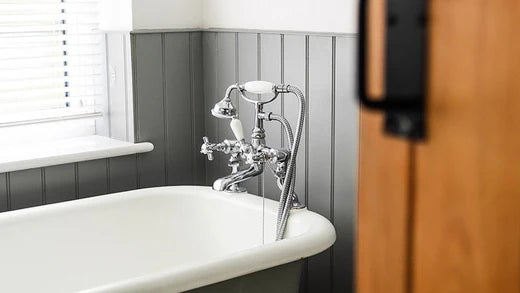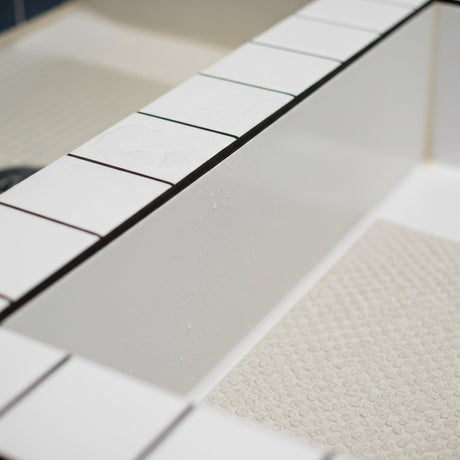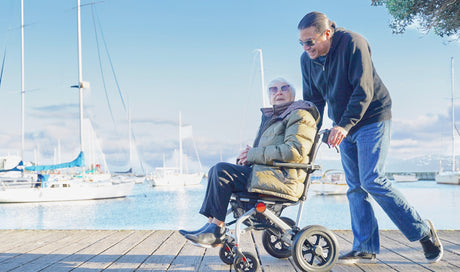The information in this article is intended as a general guide only. Consult with your occupational therapist for more information on hazards in your own home.
The recent film Adam starring Aaron Paul, tells the story of a man who became quadraplegic after a diving accident. In the film, we follow Adam’s journey from the initial rehabilitation to transport and other challenges that are no doubt familiar to many readers. One of the more heartwarming parts of the film is Adam’s relationship with his in-home carer, Yevgeniya. Of course, the scene that stuck out to us the most was when Adam was manually struggling to move from his chair into the bathtub using a plank. In another scene Adam requires the help of his father to be lifted out of the bath. These challenges are exactly the kind of hazardous movements that Showerbuddy looks to remove.
In this article we’ll cover some common issues with manually transferring into a bath, and why a system like Showerbuddy can reduce the likelihood of these.
A manual transfer puts significant strain on the body
Moving a human around is awkward and difficult. Our weight distribution is not like other heavy objects we pick up and carry in our lives. Through repeated bends, lifts and carries of a disabled individual, the support person (whether it’s a family member or care worker) can start to experience wear on their joints and muscles. Without the aid of equipment, your back, knees and neck take the full brunt of a lift into and out of a bathtub. This becomes even more hazardous if the disabled individual you’re assisting does not have a shower char; instead opting to lie in the bath.
Bend
A bending motion down into a bathtub to lift someone, while stationed outside of it, requires reaching right over an edge, putting the body in an unnatural position. But equally, safely lowering the individual into the bath can cause significant stress with the combination of bending while supporting someone’s weight.
Lift
The lift, without any hoist or aid, proves the most dangerous of the actions, with the back becoming the fulcrum for transfer of a heavy load. Over repeated transfers, strain and pain can set in, with the risk of accident increasing as the back is weakened.
Carry
Once out of the bathtub, a support person must carry the disabled individual – this may be a short distance onto a chair, or right across the whole bathroom. The carry combined with keeping steady on a moisture-covered floor, demands the body’s joints and muscles working hard. Even with the best form, a manual carry may start to wear you down.
Strain isn’t just coming from the bathtub transfer either. If you’re helping someone get into bed, onto chairs, into vehicles etc (plus going about your own daily activities), the body will wear down. Rest is absolutely essential for this reason.
A support person is at the risk of a lifting injury
Strain is bad, but a physical injury won’t just prevent you from supporting someone else, it can leave you incapacitated for a period. This can affect work, family, and other parts of your routine. This can be especially traumatic when a trusted relationship has been built up between disabled individuals and their carer.
An injury will often occur when the support person is not well rested or doesn’t have the right form or training for handling a disabled person. But sometimes injury can occur to a well experienced support worker, observing all the best practices. It’s simply that picking up and moving a human is a very difficult thing on the body.
Common injuries suffered from moving a disabled person include:
- pulled muscle in neck or back,
- hernia,
- twisted ankle or knee, or
- slip or fall resulting in a broken bone or muscle damage.
Back pain is so common for a carer as this is where much of the demand is placed during manual transfer.
Loss of grip on the individual
Moving someone around in the bathroom, naturally, will require a sturdy, secure grip. As a manual transfer is attempted when lifting the disabled person out of the bathtub, there is a real risk of them slipping out of grasp into the tub. This obviously presents injury risk to the individual – the last thing anyone should expect from what should be a relaxing bathing experience.

Bathrooms get slippery, making transfers even more risky
Floors, rails, walls – a bathroom with lots of water and steam can spell trouble for even the most capable of support people. Common accidents are caused by wet tiles, condensation on rails and walls, and loose bath mats. A slip in the bathroom is a serious hazard that may result in head trauma or broken bones that would require a hospital visit for one or both people involved in that manual transfer. In our view, the bathroom is just not the place to be taking a chance like this.
Once in the tub, bathing safely can be tricky
On top of the transfer into and out of the bath, the process of actually bathing with no support equipment can be fraught. Depending on the level of independent mobility, a standard lying down position may be unsafe for the disabled individual, even with a carer nearby.
A carer can help with washing and manageability, but this is made more difficult with a lack of adequate equipment support. For someone who is quadriplegic, this is rarely a workable solution.

Removing the individual quickly is almost impossible
Sometimes we need to stop a shower quickly, particularly if there’s an emergency like evacuating the home due to fire. If the mobility impaired individual has been manually transferred or is not in a shower chair, removal becomes very dangerous if rushed. All the dangers we’ve covered earlier become more likely.
Removing hazards and making bathing more comfortable
It’s pretty clear that manually transferring someone with mobility challenges is not the way to go. It puts strain on the carer, increases the likelihood of a slip or fall, and makes the act of bathing harder than it needs to be.
Our advice? First remove hazards like loose ground objects and ensure the safest possible bathroom environment. Read more on this in our article about shower safety.
Next, invest in a solution that takes care of the hard parts of transfer for you. We’re of course talking about the range of chairs from Showerbuddy. These transfer systems provide a comfortable, quality shower chair, transfer bridge and a secure, in bathtub base (if you have a bathtub – we provide solutions for all configurations of shower).
We want to help those with mobility challenges and their carers make bathing an enjoyable experience once again. Our solution is designed and manufactured to last the distance – all without requiring a single bit of bathroom modification. That means anyone from home owners to renters to those travelling can enjoy the benefits Showerbuddy offers.
If you’re interested in a solution like this, please get in contact with our team now.




























![Toilet Training A Young Child With Mobility Challenges [And How A Shower Chair Can Help]](http://shower-buddy.com/cdn/shop/articles/toilet-training-disabled-child_520x500_a90e5234-d372-435d-aa56-8da15dd3836c.webp?v=1722557239&width=460)






















